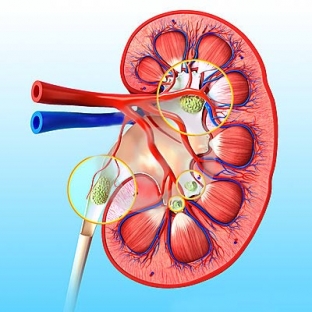Renovascular (renal) hypertension is one of the forms of renal arterial hypertension against the background of occlusion of the artery of the kidneys. The frequency of renovascular arterial hypertension is 1% of all cases of hypertension, one fifth of all persistent arterial hypertension and one third of rapidly progressive malignant arterial hypertension.
The treatment of renal hypertension has its own challenges. For example, in the treatment of renal hypertension, there is a decrease in the effectiveness of certain groups of drugs. At the same time, people continue to take them, putting themselves at risk. Why this happens, read in our article.
Main causes of renal hypertension
There are two common causes of renovascular hypertension - fibromuscular dysplasia and atherosclerosis of the main arteries. There are rare causes of renal hypertension, which include nonspecific aortoarteritis (Takayasu's disease), abdominal trauma, thrombosis of the renal arteries (a complication of medical interventions), polyangiitis nodosa, atrial fibrillation, abdominal aortic aneurysm, parapelvic cyst of the kidney, kidney tuberculosis, anomalies in the structure of the kidney, leading to to kink or compress the arteries of the kidney.
Renal artery stenosis occurs most frequently, in 70% of cases, and is found predominantly in the elderly. Usually atherosclerotic plaques are located in the mouth. The progression of atherosclerosis with the development of stenosis, which is hemodynamically significant, provokes the development of impaired renal function in the context of coronary kidney disease.
Main risk factors for renal artery stenosis and renal hypertension:
- Diabetes mellitus.
- Smoking.
- Common atherosclerosis (especially of the branches of the abdominal aorta).
- Hyperlipidemia.
How does fibromuscular dysplasia affect the development of renal hypertension?
Fibromuscular dysplasia is the cause of renal hypertension in the remaining 25-30% of cases. Fibromuscular dysplasia is a disease of the vascular wall of a non-inflammatory nature. There is a transformation of the smooth muscle cells of the media into fibroblasts, during which there is an accumulation of bundles of elastic fibers at the border with the adventitia.

This leads to the formation of stenoses, which alternate with areas of aneurysmal expansions. So, the artery takes the form of a rosary. Renal artery stenosis associated with fibromuscular dysplasia is the cause of severe arterial renal hypertension in childhood or young age. This pathology often develops on the right and rarely has a bilateral character.
What are the mechanisms of the pathogenesis of renal hypertension?
In the pathogenesis of renal hypertension, the main link is the activation of the renin-angiotensin-aldosterone system due to a decrease in the blood supply to the kidney on the side of its lesion. Stenosis of the renal artery leads to a decrease in pressure below the site of its narrowing. This stimulates the secretion of renin by the kidneys and the formation of angiotensin II. Such mechanisms significantly increase systemic blood pressure.
The feedback mechanism, which consists in inhibition of renin secretion in response to an increase in blood pressure, does not occur due to narrowing of the renal artery. This is manifested by a persistent increase in the concentration of renin in the ischemic kidney tissue and the preservation of high blood pressure numbers.
In the case of unilateral kidney damage, a healthy kidney begins to excrete sodium intensely, while the mechanisms of self-regulation of renal blood flow are disrupted in this kidney, which are aimed at preventing damage to it in systemic renal hypertension.
Why do antihypertensive drugs fail over time?
At the initial stage of renal hypertension, blockers of the renin-angiotensin system cause a pronounced decrease in blood pressure. Late stages of arterial hypertension are characterized by sclerosis of the contralateral kidney due to hypertonic damage to its tissue. Such a kidney is no longer able to excrete water and sodium, and the mechanism for the development of arterial hypertension is no longer renin-dependent, but sodium-volume-dependent.
Therefore, taking blockers of the renin-angiotensin system in the late stages of renal hypertension no longer has an effect. The ischemic kidney becomes sclerotic and decreases in size. The same process occurs in the contralateral kidney due to hypertensive damage. With long-term arterial hypertension, the development of renal failure occurs in this way.
Therefore, if the antihypertensive drugs of the above groups are found to be ineffective, the patient should be examined, and then another treatment regimen with one or two antihypertensive drugs in combination with salt restriction should be prescribed.







Add a comment